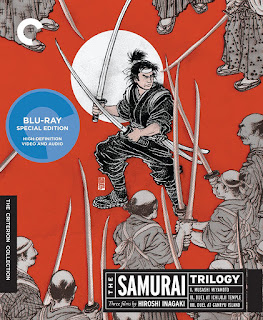Samurai I: Musashi Miyamoto
Director:
Hiroshi Inagaki
Distributed by:
Toho Studios
Released:
November 1955 (U.S.)
Country:
Japan
From
an American perspective, there are few well-known actors who don’t speak
English as their primary language. Americans know folks like Max
von Sydow, Gerard Depardieu, and Sophia Loren, but mostly because
we have seen them in American films. Yes,
Japanese actor Toshiro Mifune did a few American projects—Grand Prix (1966), Steven Spielberg’s 1941 (1979), and the miniseries Shogun (1981 come to mind—but he is a
star for his Japanese work, especially with the great director Akira Kurosawa. Mifune is truly a special actor, as anyone who
has seen The Seven Samurai (1954), Throne of Blood (1957), or Yojimbo (1961) knows, but from 1954 to
1956, Mifune worked with Director Hiroshi Inagaki to make the highly-regarded Samurai Trilogy, the first of which, Samurai I: Musashi Miyamoto, was awarded
a Special/Honorary Academy Award for outstanding foreign film, the last time
the award was given non-competitively.
 |
| Mifune not buying the damsel-in-distress bit |
The
story starts with the end of a battle. Takezo,
played by Mifune, and his buddy Matahachi are young up-and-comers, ambitious
warriors who want to make names for themselves.
Unfortunately for them, they are on the losing side of the Battle of
Sekigahara, a real battle that took place in 1600 Japan. Being on the losing side means they are on
the run, hiding from the victors. They
take up with a mother and daughter who are somehow mixed up with a gang of thieves. Takezo fights off the bad guys, protecting
these two damsels-in-distress.
Only
these women aren’t quite as innocent as they seem. Almost right away the daughter hits on
Takezo, but he resists his urges because of his samurai code, not wanting to
dishonor himself. So now with the
daughter rejected, her widowed mother decides to take a crack at him. Takezo essentially tells the mother that he
didn’t want the daughter, so why would he want her, and what’s the deal with
all the horny women around here? In this case,
the spurned woman takes things personally, and tells everyone, including
Matahachi, that Takezo sexually assaulted her.
Matahachi has a serious girl, Otsu, back home waiting for him, but has
had his eye on the daughter and is willing to be less honorable with her when she shifts her interests to him. He takes the women’s side against his friend,
and Takezo, now on the run, thinks his chum has turned on him. This eventually leads to Takezo being
justified in setting his sights on Otsu. I mean, she's fair game now, right?
As for Matahachi, before long he is wishing he had kept his proverbial samurai
sword sheathed. He has to marry the annoying
girl and deal with a nagging mother-in-law.
 |
| Yojimbo: Mifune is much more fun to watch as a ronin |
As
the title indicates, Samurai I is the
first film, and so the story is going to be left unfinished. The film is entertaining enough as a set-up,
but I left unsatisfied, waiting for another time to catch Parts I and
II. Watching Mifune act is always a
pleasure, but it seems to me his potential is untapped in this film, admittedly
allowing for growth of the character in the next two films. Samurai
I is a good-looking film, with colorful fight scenes and good photography,
and the trilogy was an influence on Quentin Tarantino’s Kill Bill movies (2003-4).
With the caveat of only having seen the first film, I couldn’t help but think
it didn’t compare well to Kurosawa’s samurai films, even though the ones with Mifune
are all black and white. Color cannot take the place of masterful direction.
The Title:
宮本武蔵. The trilogy is based on a Japanese novel from the 1930’s. The titular character, Musashi Miyamoto, who goes by Takezo in this film, was a real person. He identified himself as Shinmen Musashi-no-Kami Fujiwara no Harunobu in his
own book, The Book of Five Rings, written
about 1645. Miyamoto is considered Japan’s
most famous and greatest swordsman, probably because he wrote a book about
it. Marketing is everything, even in
feudal era Japan.
The culture:
The philosophy of the Samurai is on full display, before the
modernization of Japanese society and Western influence. Incidentally, a “ronin” is a samurai without
a master, and is really what the Mifune characters in Seven Samurai and Yojimbo
are.
Agenda danger:
Takezo and his pal Matahachi definitely get the short end of the stick
in regards to their dealings with the sneaky mother/daughter combo they
help. The false rape accusation doesn’t
put the women in the greatest of lights, but Otsu balances out any misogyny the viewer may feel coming on, by
being an all-around Japanese girl you’d want to bring home to your mama-san.
Best Picture that year: Marty. Ma! I'm ugly, Ma!
Rating:
I feel like I have to give this one an I for Incomplete. I’m not sure why the Academy chose to honor
this film with the series just getting started—imagine Lord of the Rings: The Fellowship of the Ring winning Best Picture
and not The Return of the King. Still, if you are looking for some violence
with a little romance thrown in and some great acting (like say, From Here to Eternity), you’ll enjoy
this one.

No comments:
Post a Comment